
The Essential Guide to Equalizing Audio Volumes in VLC Media Player for 2024

The Essential Guide to Equalizing Audio Volumes in VLC Media Player
How To Normalize Volume in VLC
How to normalize volume, why should we do it, and what is it after all? – these are the questions when it comes to editing our audio files, as well as the video clips we tend to change the sound of. So, first of all, the volume normalization is pretty much explained as follows: The process when a constant amount of gain is applied to the audio recording, bringing the amplitude to a desirable level, which is “the norm” for the project. If it is a little bit difficult to understand, we have to highlight that when this tool is applied to our volume, the whole recording has the same amount of gain across it, every piece affected the same way. Accordingly, when we normalize volume, the relative dynamics are not changed.
But, why bother at all and why not leave it the way it is? Well, the answer to this is almost the same as on why editing exists in general, right? Things are not perfect! This is the fact that prompts us to make our video clips and audio better, improve it at least on the level which can get us the right amount of viewers and listeners. Everyone have had some pain listening to several podcasts, when the volume was too high or too low, or there were so much background noise that the whole recording was hurting the ears of a person! People will not convert to being loyal subscribers, viewers and listeners if their user experience is not favored. So, it is in our best interest to serve their best interest, with a little bit of editing.
When it comes to normalizing audio, there are two reasons we refer to this tool. First is when we feel we need to get the maximum volume, and the second is when we need to match different volumes.
In the first case, you might have somewhat quite voice recording, and would like to make it better without changing its dynamic range, while making it as loud as possible. And when it comes to matching volumes, it is logical that you need to manipulate your editing this way in case you have a group of audio files, each or some of them are at different volumes, so, understandably, if not necessarily, you would like to make them come closer to the same volume.
So, until we give you the step-by step guide on how to normalize your volume in VLC player, we also need to inform you about audio normalization types. Here, generally, we come across three of them: a so-called peak normalization, helping adjust the recording based on the highest signal level present in the recording; another is called loudness normalization and it adjusts the recording based on perceived loudness. Last but not least, RMS (Root-Mean-Square), changes the value of all the samples, where their average electrical volume overall is a specified level.
Using any of this, making it better to listen to your voice, without people being annoyed and their ears becoming exhausting with what you have to offer, you will be making it enjoyable for them and easy to come back to your content, as they will not be obliged to change the volume on their own audio players. Instead, their experience with you will be calm and effortless, which you are aiming to achieve.
So, not, what about VLC? – this is a very popular media player, favorite for a lot of people all around the world, so you should already be quite familiar with what it is, at least by having streamed videos and movies there. Speaking more of what it represents, it is a free-to-use, robust, and feature-packed software that plays a wide range of audio, image, and video files. It is worth noting that it can also play multimedia files directly from extractable devices or the PC and additionally, the program can stream from popular websites such as Disney+, Hulu, Netflix, and so on.
As if it was not enough, you can do simple video and audio editing in VLC Media Player, which a lot of people are unaware of! For example, you can easily trim and cut videos. So, as it happens, we can also normalize volume in VLC Media Player. It is a very handy feature and it works on Windows as well as on Mac. Sooo… How to do that? Because, actually, it is so simple that you might be surprised you didn’t know about this earlier. To learn how to normalize volume in VLC, follow this simple guideline:
First, of course, as every time working with any software, you need to have VLC Media Player installed on your device. Once you have it installed, open VLC. Go to the Tools and Preferences and there, you will need to check the single box which is next to Normalize volume in Effects. Now, set the level to the one that works best for you. Then, when you are happy with the result, you can Save.
This is not something perfect, because it’s so simple to do and actually what it does is just help adjust the general volume, so it leaves the specifics alone.
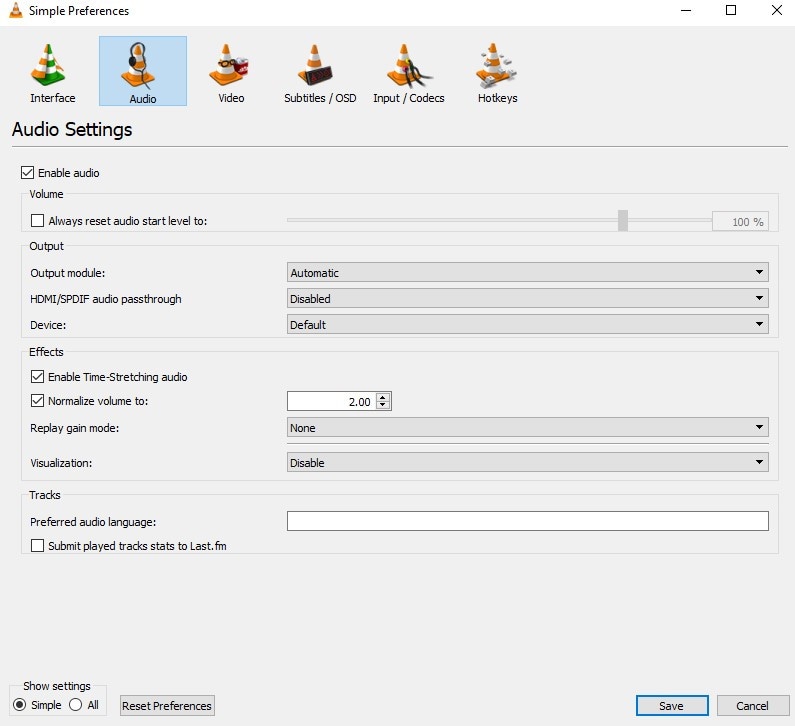
But, it might be the case that you are not so satisfied with the simple editing and want a little more to get from the editing process on VLC. So, you can do more with the Audio Effects menu there. And the steps are as follows:
First, on your VLC player, find Tools and then, in the menu, go to Preferences. The window will open, and there you need to select All in Show settings – actually it is a little bit hard to find because this is in the bottom left corner of the window. From there, you will need to navigate to Audio, and then, a little below, click on Filters and highlight it. The checkbox next to the Dynamic range compressor will probably be unchecked – so, check in it.
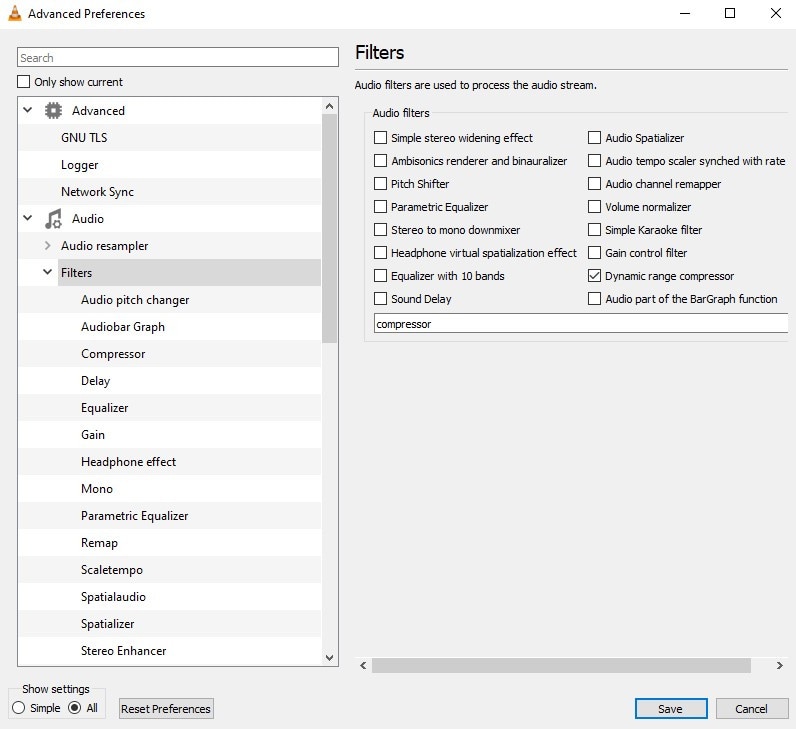
Next, see where Compressor is in the left panel? Select it. And now, you are free to make the changes to the levels as you see fit.
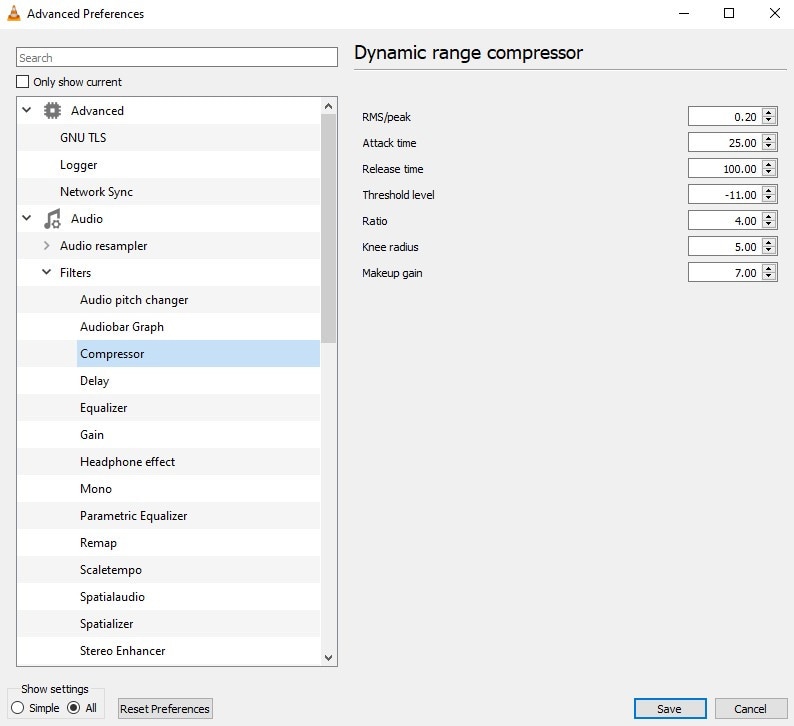
Here, if you are a little bit overwhelmed with the wide range of options to work on, you can just concentrate the most on Makeup gain, Threshold, and Ratio. The first one is by which you adjust in quiet sequences to raise the volume, the second will help you reduce louder sequences to even things out, and ratio is the maximum level of all audio within a movie, let’s say.
Don’t underestimate Attack time and release time, either. They graduate the changes to ramp them up at first, then down again, rather than initiating them immediately. So, if you set them to your liking as well, this will ensure that you have a more fluid transition in and out of the scene and there are less sudden, sometimes scary volume changes.
Therefore, you are now equipped with the most information you will need to normalize volume in VLC Player – so free to give it a go, play around with the different settings and carry out the best result imaginable for you!
How to normalize audio in Wondershare Filmora?
Now, even though we already know how to normalize audio in VLC in the simplest, as well as in the more advanced way, it might be even better if we know some more about normalizing audios in different programs. Something worth discussing is a software called Wondershare Filmora , which carries out the same task wonderfully. Although, unlike VLC Media Player, it is a real video editor , but don’t panic if you have never laid your hand on editing – it is one of the easiest to use ini the word, operating also both on Mac and Windows, and its interface is utterly understandable for beginners right away. And, actually, it is a qhile that Wondershare Filmora X introduced the feature to normalize the audio for the first time. What to say more - you might want to stop now and download the latest version of Filmora because now we are about to learn how to normalize audio from the video there – so, tune in!
Free Download For Win 7 or later(64-bit)
Free Download For macOS 10.14 or later
When it is done installing, open the software. Now, click and drag the video of which the audio you want to normalize. Now you can select the clip you have chosen – if there are multiple, select all of them, then right-click and choose Detach Audio.
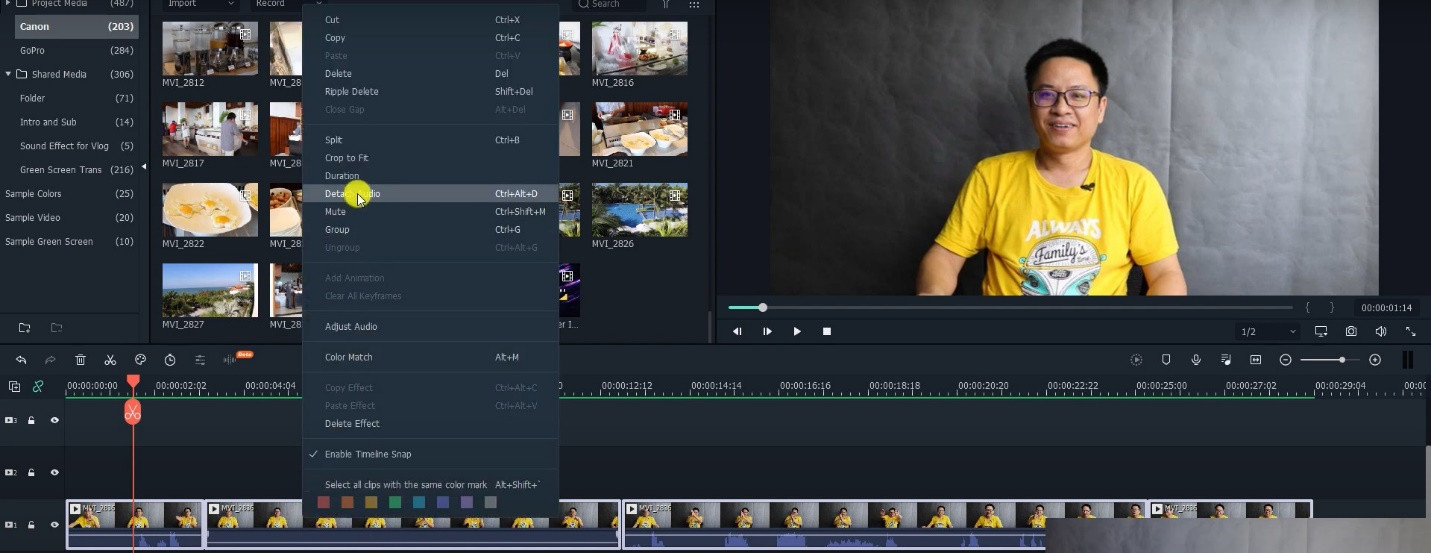
Now if you have this kind of graphic before your eyes, you can be pretty sure without even listening, that the noises are really, really different from each other, which highlights once again how useful audio normalization can be:

Select these files, right-click and choose Adjust Audio. New panel will be opened on left top and there, you will see Audio Normalization – check the box there.
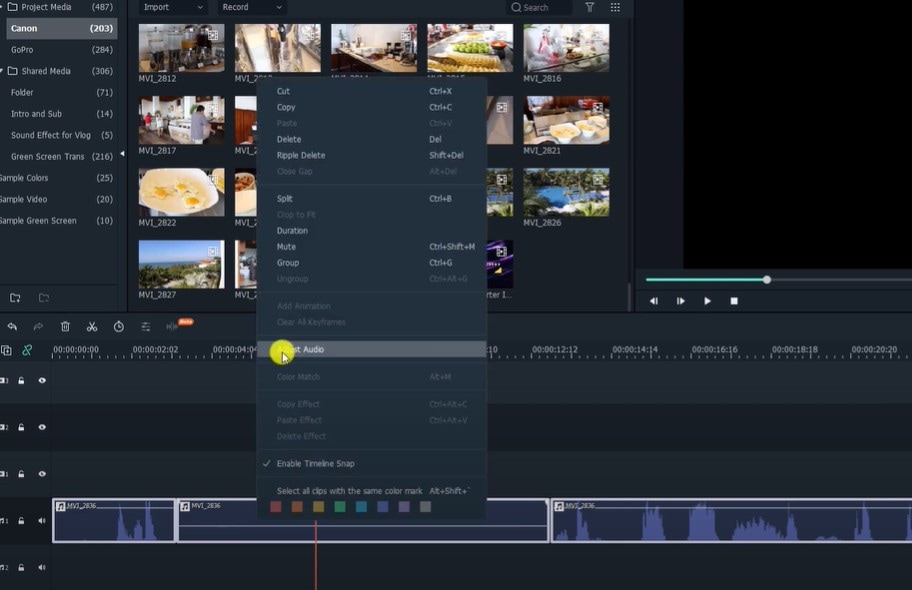
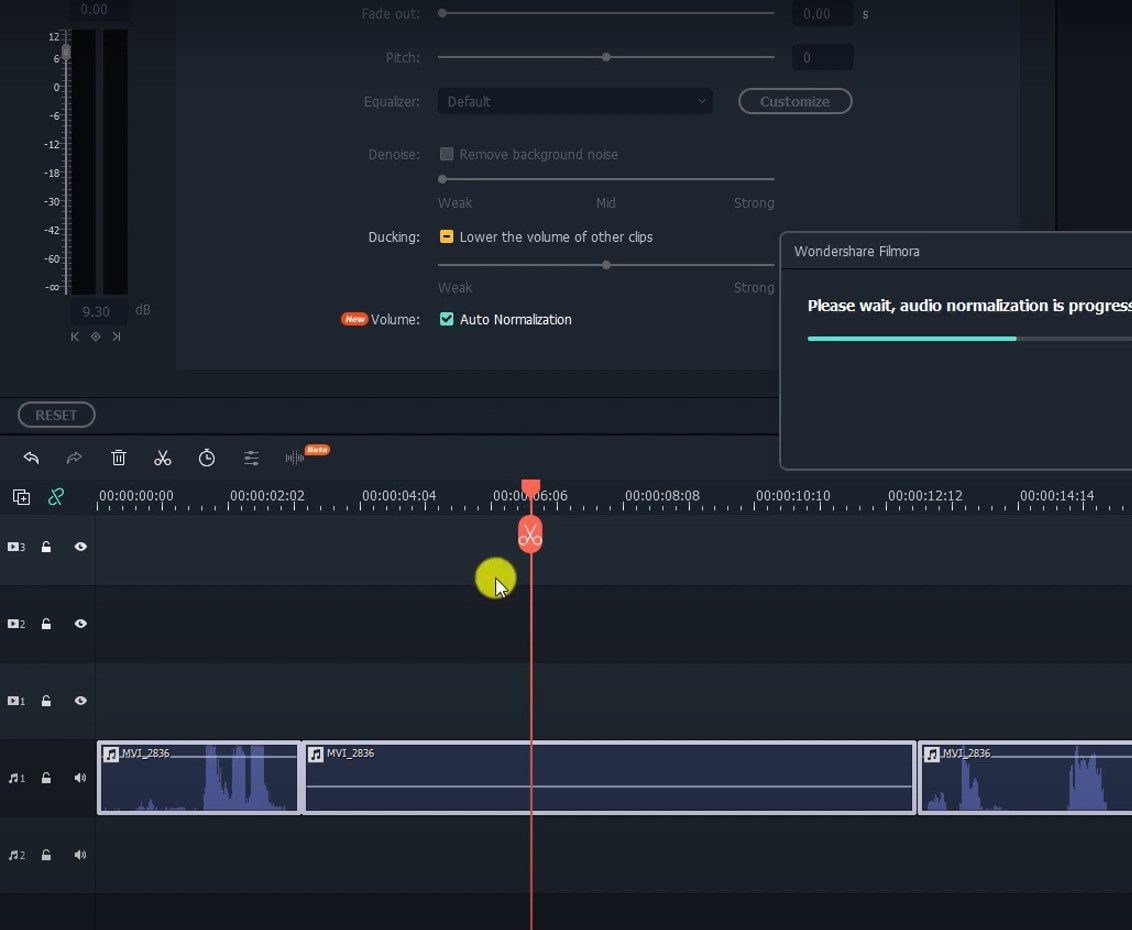
After you have clicked on it, wait until the normalization completes.

Soon, all audio will be normalized, and you will already be able to see on the graphics that the volumes are almost on the same level and when you listen to it, you will make sure that there is no longer apparent difference between how they sound. And from there on, you can save the file you just normalized!
So, in this article, we learned a lot about normalizing volumes, why and how it is done, and, more specifically, how to get this task completed in VLC Media Player as well as in Wondershare Filmora X. you can proceed to putting this new information into a good use and come back to learn more about video and audio editing here!
Free Download For macOS 10.14 or later
When it is done installing, open the software. Now, click and drag the video of which the audio you want to normalize. Now you can select the clip you have chosen – if there are multiple, select all of them, then right-click and choose Detach Audio.

Now if you have this kind of graphic before your eyes, you can be pretty sure without even listening, that the noises are really, really different from each other, which highlights once again how useful audio normalization can be:

Select these files, right-click and choose Adjust Audio. New panel will be opened on left top and there, you will see Audio Normalization – check the box there.


After you have clicked on it, wait until the normalization completes.

Soon, all audio will be normalized, and you will already be able to see on the graphics that the volumes are almost on the same level and when you listen to it, you will make sure that there is no longer apparent difference between how they sound. And from there on, you can save the file you just normalized!
So, in this article, we learned a lot about normalizing volumes, why and how it is done, and, more specifically, how to get this task completed in VLC Media Player as well as in Wondershare Filmora X. you can proceed to putting this new information into a good use and come back to learn more about video and audio editing here!
Essential Techniques for Silencing Background Sounds: Off- and Online Solutions
Videos are like a hook that keeps us engaged for a good long time. Similarly, they are a great medium of information and entertainment. Good video content help us learn better and to memorize the information in it. However, this can be a problem when videos have issues like annoying background noises. Even distortion or jittery sound can turn a good-quality video into a poor source.
Nevertheless, there is a solution to almost every problem. There are tools that can help to remove distortion and background noises from a video. Such tools will help you reduce audio noise in the background or any distortion in your media file. You can download such software that will help you denoise your media content. In this way, your content will sound crispier and sharper with better audio quality.
Part 1: What Are The Benefits of Audio Denoising in Videos?
There are tools that will help you reduce noise from audio without any hassle. Such tools are very useful when it comes to removing distortion from your audio files. You can also denoise your files, but first, learn some of the benefits of audio denoising.
1. Clear Sound Quality
Audio denoising help to clear any unwanted noise, hiss, or any other background voice. This feature helps to improve the overall listening experience of the user. Once all the distortion is removed, the audio of your project will sound better and more polished.
2. Optimized Communication
Having clear and clean audio is important in videos for effective communication. Moreover, it makes sure that viewers can easily understand the dialogue or message. Better sound quality also improves the overall communication within the project or a video.
3. Professional and Factual
When there’s background noise or disturbances in the audio, the content appears to be faulty. It also can make the video less professional and not as trustworthy. If we remove the background noise, it helps the video to look more meaningful and professional.
4. Enhanced Audience Involvement
Clean sound keeps people interested and helps them stay attentive to the story. Moreover, people tend to be hooked more to the information in the video. It helps viewers to stay engaged, follow what’s happening, and enjoy watching the video.
5. Availability and Diversity
Reducing background noise makes the speech clearer and easier to follow. Additionally, when subtitles or captions are available, then it makes the video more captivating. This makes the videos more accessible to more people with diverse backgrounds.
6. Adjustable Editing Opportunities
Removing unwanted noise from the audio while editing a video gives us more flexibility. By doing so, you can work on your project later. Clean audio allows us to make accurate changes to the sound, like adjusting the volume or adding effects. Additionally, it makes your audio file better than before.
7. Uniformity and Uninterrupted Flow
By eliminating noise, each video part will have a similar sound profile. Meanwhile, this will create a smooth and uninterrupted audio experience for the viewers. Consistent audio quality is important in providing a seamless and unified viewing experience.
8. Audio Reconstruction
Eliminating such noises from audio is very helpful for fixing older or damaged recordings. It enhances the quality and makes it easier to understand audio. You can even reconstruct your old audio files and keep them safe. This will also help you to improve the quality of your old audio files.
Part 2: Wondershare Filmora: How To Denoise Audio Properly?
Wondershare Filmora is a comprehensive video editing software that features many effective video management tools . From video editing to denoise audio editing, everything is possible in Filmora. For those who are new to this tool, Filmora makes it very easy to manage such videos. To know how you can using Wondershare Filmora, look below into the steps:
Reduce Video/Audio Noise For Win 7 or later(64-bit)
Reduce Video/Audio Noise For macOS 10.14 or later
Step 1Add Audio with Noise on Filmora
On opening Filmora on your computer, continue to select the “New Project” button from the home screen. As this opens a window, continue to the “Import” options to add in the video or audio that needs editing. Drag and drop it to the timeline to continue with free audio noise removal.
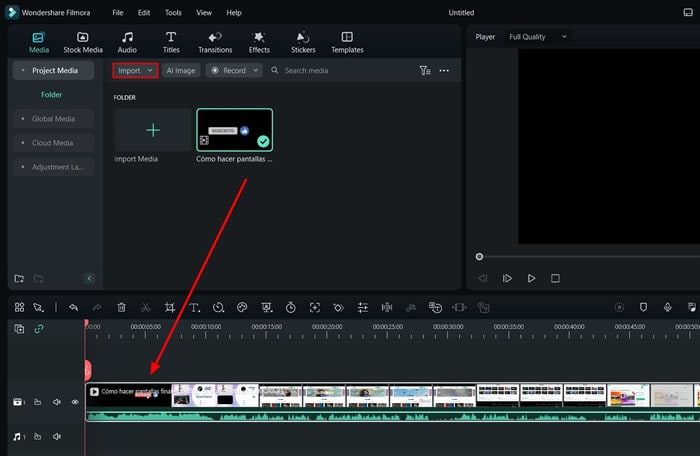
Step 2Adjust Audio Settings
As the media is imported successfully, right-click to open a list of options. Select “Adjust Audio” from the drop-down menu to open the audio settings on the screen.
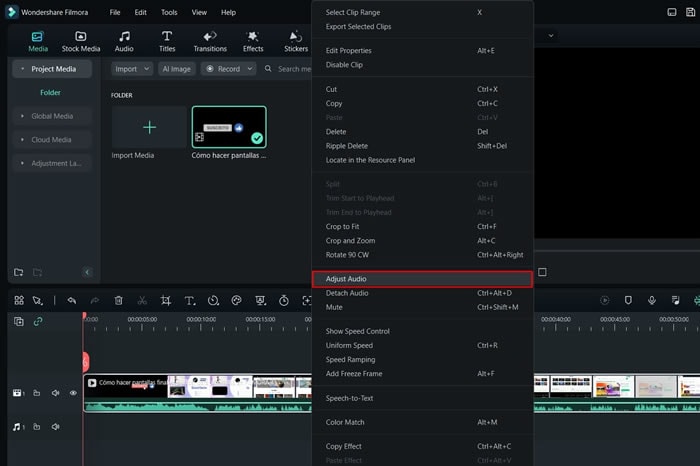
Step 3Successfully Denoise Audio
In the “Denoise” section, you can activate options such as “AI Speech Enhancement,” “Wind Removal,” and “Normal Denoise.” Also, you can set the sliders of “DeReverb,” “Hum Removal,” and “Hiss Removal.” After correcting the audio, click the “Export” button for opening the window to save the final product.
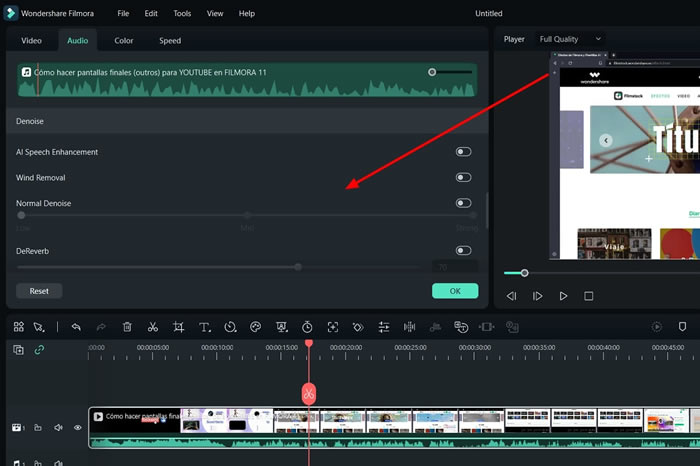
Part 3: Online Solutions: Reduce Audio Noise With The Right Tools
Your noise distortion or annoying background sounds is no more a hassle. These top 3 free audio noise removal online tools will help you with your problem. In this section, the steps of how to use these audio deniosers are also provided.
1. Media.io
Media.io is one of the most comprehensive video enhancers and editors out there. It can improve the quality of your images and also can edit your videos in a breeze. Besides this, it is also a great online audio noise reducer. You can import your audio files and simply let the tool eliminate all the distortion from your file.
Step 1: Access the online tool by going to its website. As you continue next, select the “Remove Noise Now” button to lead to a new window. Then, drag and drop your audio file from your system.
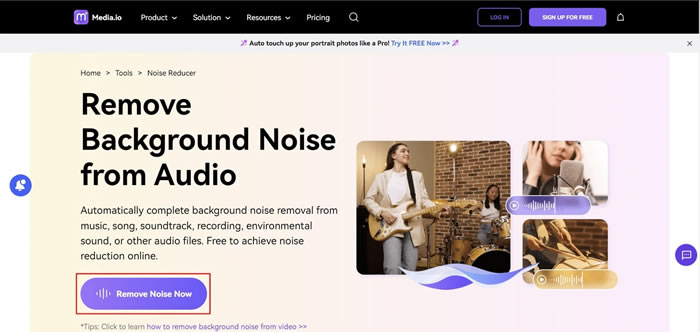
Step 2: Next, in the “Noise Reducer,” select the type of noise you want to remove from your audio file. You can select any of the provided options for removing the type of noise present in your content. Once selected, select the “Reduce noise now” button to initiate the process.
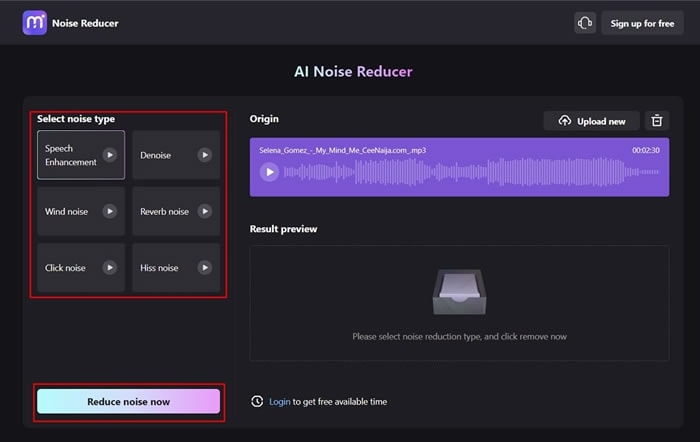
Step 3: Continue to preview your audio file under the “Result Preview” option. Proceed to download the file once completed by pressing “Download.”
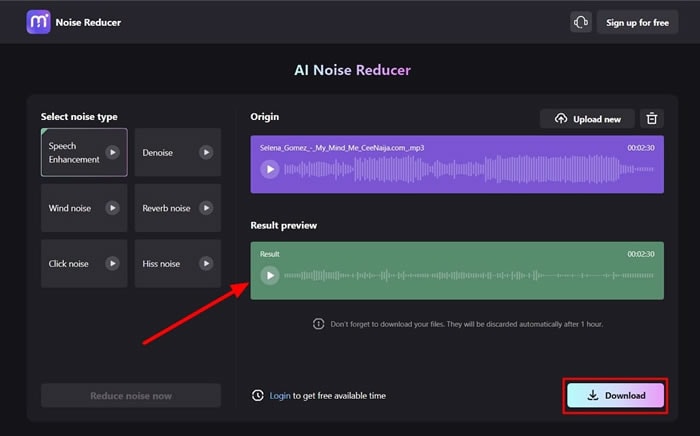
2. Veed.io
This online video editor provides a diversity of features to its users with qualitative assurance. Not only can you edit videos, but Veed.io provides the feasibility of editing audio. If you have recorded content with background noise, it can be easily removed using Veed.io . To know how this noise cancelling online tool works, follow the steps as follows:
Step 1: On opening the browser screen and navigating to the official link of Veed.io, click the “Clean your audio now” button.

Step 2: You will be led to a new window where you can add the distorted video or audio. Open importing it successfully on Veed.io, continue to the “Settings” section from the left, and look for the “Audio” settings.
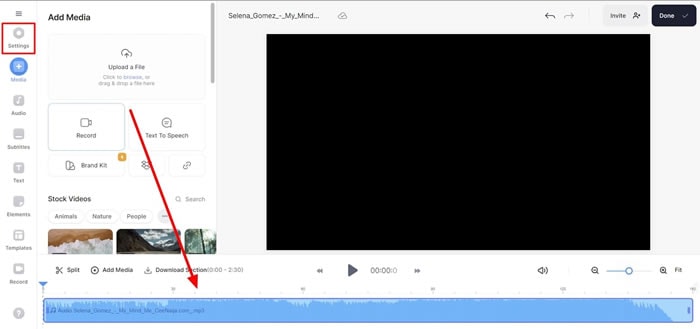
Step 3: To remove background noise from the audio, click the “Clean Audio” button and access “Done” from the top-right corner. Continue to export the video successfully from Veed.io background noise remover.
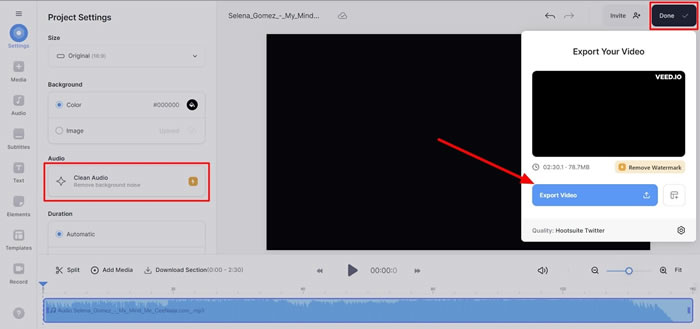
3. Kapwing
Another impressive online video editor, Kapwing , provides its users with the option of removing noise from audio. With a clean and simple interface, it is not difficult to reduce audio noise through Kapwing. For an understanding of how this audio noise reduction online free tool works, follow the steps below explaining the operations of Kapwing:
Step 1: As you access the online webpage of Kapwing, click the “Upload video or audio” button to continue further.
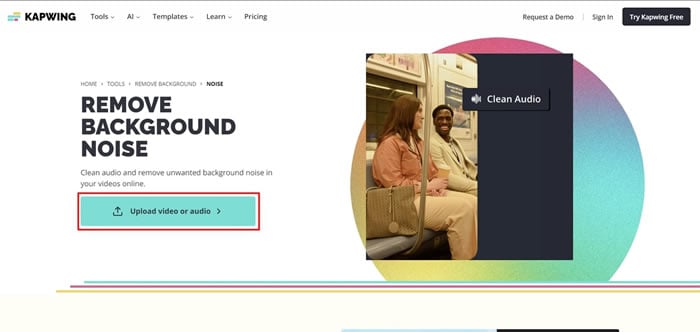
Step 2: As you tap the “Upload” button on the new window and add your video, a new editing section opens on the right panel.
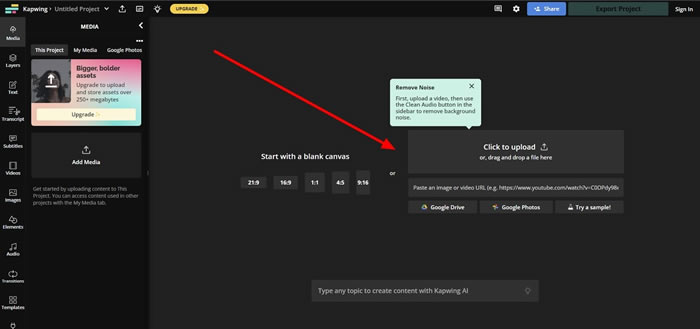
Step 3: Look for the “Clean Audio” button in the “AI Tools” section on the right to remove the audio noise from the added media. Once it is done, click the “Export Project” button on the top to download the edited video successfully.
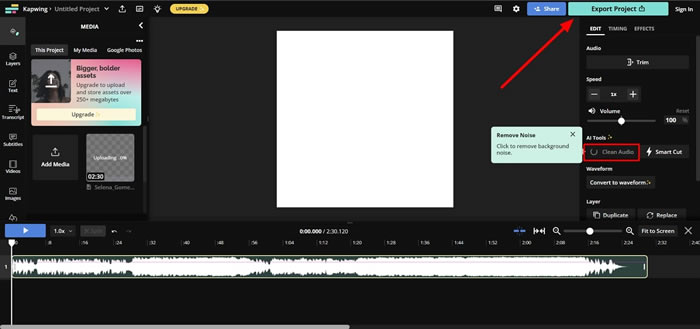
Conclusion
To conclude, videos are a great source of entertainment and information for almost everyone. So, why go for a video with too much distortion and jitters? Wondershare Filmora has added an excellent feature to denoise your video or audio files . This tool has a feature to reduce or remove background noises or distortion from your videos. With this feature, your video files will have a more clear and sharp audio sound.
Reduce Video/Audio Noise For Win 7 or later(64-bit)
Reduce Video/Audio Noise For macOS 10.14 or later
Reduce Video/Audio Noise For macOS 10.14 or later
Step 1Add Audio with Noise on Filmora
On opening Filmora on your computer, continue to select the “New Project” button from the home screen. As this opens a window, continue to the “Import” options to add in the video or audio that needs editing. Drag and drop it to the timeline to continue with free audio noise removal.

Step 2Adjust Audio Settings
As the media is imported successfully, right-click to open a list of options. Select “Adjust Audio” from the drop-down menu to open the audio settings on the screen.

Step 3Successfully Denoise Audio
In the “Denoise” section, you can activate options such as “AI Speech Enhancement,” “Wind Removal,” and “Normal Denoise.” Also, you can set the sliders of “DeReverb,” “Hum Removal,” and “Hiss Removal.” After correcting the audio, click the “Export” button for opening the window to save the final product.

Part 3: Online Solutions: Reduce Audio Noise With The Right Tools
Your noise distortion or annoying background sounds is no more a hassle. These top 3 free audio noise removal online tools will help you with your problem. In this section, the steps of how to use these audio deniosers are also provided.
1. Media.io
Media.io is one of the most comprehensive video enhancers and editors out there. It can improve the quality of your images and also can edit your videos in a breeze. Besides this, it is also a great online audio noise reducer. You can import your audio files and simply let the tool eliminate all the distortion from your file.
Step 1: Access the online tool by going to its website. As you continue next, select the “Remove Noise Now” button to lead to a new window. Then, drag and drop your audio file from your system.

Step 2: Next, in the “Noise Reducer,” select the type of noise you want to remove from your audio file. You can select any of the provided options for removing the type of noise present in your content. Once selected, select the “Reduce noise now” button to initiate the process.

Step 3: Continue to preview your audio file under the “Result Preview” option. Proceed to download the file once completed by pressing “Download.”

2. Veed.io
This online video editor provides a diversity of features to its users with qualitative assurance. Not only can you edit videos, but Veed.io provides the feasibility of editing audio. If you have recorded content with background noise, it can be easily removed using Veed.io . To know how this noise cancelling online tool works, follow the steps as follows:
Step 1: On opening the browser screen and navigating to the official link of Veed.io, click the “Clean your audio now” button.

Step 2: You will be led to a new window where you can add the distorted video or audio. Open importing it successfully on Veed.io, continue to the “Settings” section from the left, and look for the “Audio” settings.

Step 3: To remove background noise from the audio, click the “Clean Audio” button and access “Done” from the top-right corner. Continue to export the video successfully from Veed.io background noise remover.

3. Kapwing
Another impressive online video editor, Kapwing , provides its users with the option of removing noise from audio. With a clean and simple interface, it is not difficult to reduce audio noise through Kapwing. For an understanding of how this audio noise reduction online free tool works, follow the steps below explaining the operations of Kapwing:
Step 1: As you access the online webpage of Kapwing, click the “Upload video or audio” button to continue further.

Step 2: As you tap the “Upload” button on the new window and add your video, a new editing section opens on the right panel.

Step 3: Look for the “Clean Audio” button in the “AI Tools” section on the right to remove the audio noise from the added media. Once it is done, click the “Export Project” button on the top to download the edited video successfully.

Conclusion
To conclude, videos are a great source of entertainment and information for almost everyone. So, why go for a video with too much distortion and jitters? Wondershare Filmora has added an excellent feature to denoise your video or audio files . This tool has a feature to reduce or remove background noises or distortion from your videos. With this feature, your video files will have a more clear and sharp audio sound.
Reduce Video/Audio Noise For Win 7 or later(64-bit)
Reduce Video/Audio Noise For macOS 10.14 or later
Best Affordable Web Platforms for Equalizing Auditory Content
What is Audio Normalization, what are its different types, why do we need it and how to do it online? – these are the questions we might ask when first learning about it. Well, then, let’s answer all of them!
Audio Normalization means that the loudest parts of an audio signal are set to a specific value. For example, -18 dBFS (decibels relative to full scale). This is done so that all the parts of the sound mix remain at equal volume levels.
You can use this tool when mixing or editing your music, or during playback on your speakers. In the case of mixing, listen for any clipping (A form of waveform distortion - It sounds like the audio is starting to ‘break up,’ which is light distortion. The more severe it is, the more distorted the music begins to sound) that could occur in your mix. So, in this case, you need to normalize before it becomes too loud and needs more and more fixing. So, normalizing the audio kind of means balancing the volume of the track.
Mostly, audio normalizers are used for balancing out the volume of music, podcast, or other audio recordings. Whenever you have a variety of audio clips that would sound too loud or soft if listened to together, an audio normalizer helps you create a more cohesive listening experience. So, why, and when, do we need to normalize our tracks?
- To make different music styles sound more cohesive;
- To adjust the volume of podcast to be at a consistent level with one another
- To remove sharp spikes in volume for consistent listening experience for our audiences
So, what are the types of audio normalization? Here you have it:
- peak normalization - helps adjust the recording based on the highest signal level present in the recording;
- loudness normalization - adjusts the recording based on perceived loudness;
- RMS (Root-Mean-Square) - changes the value of all the samples, where their average electrical volume overall is a specified level.
So, say that if you are a creator and have listeners, with this tool, you can count on the expectation that people will more likely want to convert to being loyal subscribers, viewers and listeners. This is what happens when audiences feel their user experience is favored and they enjoy a good content – it makes them come back for more.
But sometimes you don’t have so much time that would allow you to find a software, download its installer, install it, learn how to navigate inside its interface, which might be totally new and in some cases, complicated for you, and learn how to normalize your audio files there. In this case, you might want to find the right tools which would enable you to reach your goal without even having to install anything – simple and fast!
Hence, for this case, we would like to offer you the list of 10 best free online audio normalizers. The list goes:
- MP3 Gain Volume Changer
- Sodaphonic
- Audio Mass
- Audio Online Convert
- Audio Editor
- fConvert Online Converter
- Boost MP3 Volume
- MP3Cut Change Volume
- Audio Alter Volume Changer
- Audio Trimmer Volume Booster
Therefore, let’s delve into each one of them, and learn how to use those online editors in our favor!
MP3 Gain Volume Changer
This online editor allows you to adjust the volume level of MP3 audio files fast – it can raise, lower, and normalize the volume level of your MP3 files.
The interface is simple and easy to use – exactly what you must be looking for. You can adjust the volume level to make the MP3 the way you want to listen to it.
One of the important things this app is letting you do is to upload from Google Drive or Desktop – it works locally without going through a server, and this means that MP3s do not need to be uploaded to any server.
So, go to this link . Click on Choose Files and find the audio clip you would like to normalize.
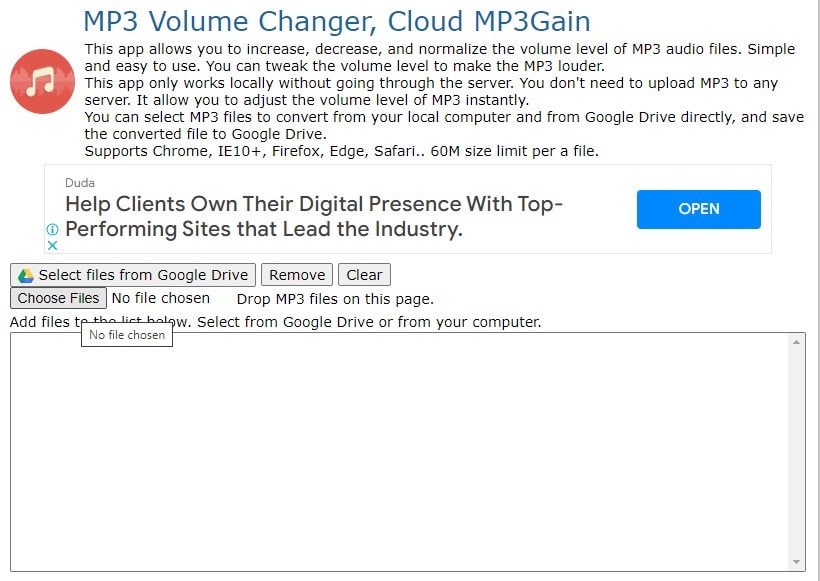
Now, once your audio track is added, head a little below and find the options you have.
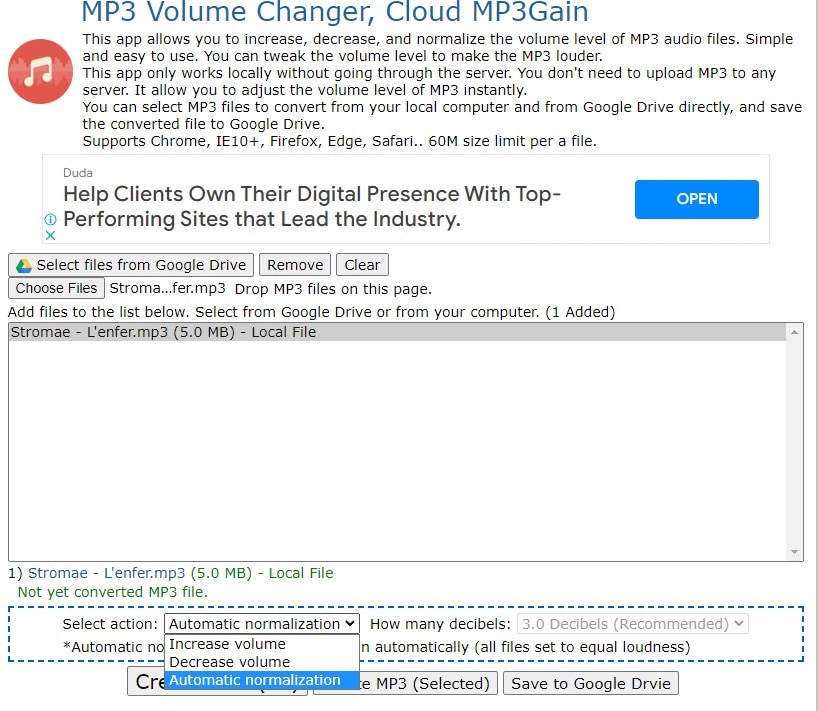
Here, you can decide what do really do with your file: do you want to increase or decrease the volume? If you choose automatic normalization, the app will figure something out itself! And, look at the right side – in case you know well your decibels, you can choose how many decibels to apply. But the web-site itself says that 3.0 decibels is recommended, so it would be nice to just stick with it.
If you have multiple files and you want to normalize them all at once, click on Create MP3 (All); in case you have a lot of files and you would like to normalize one or more of them but not all, then your best choice would be Create MP3 (Selected). Another option is that you save your file on Google Drive.
When you Create your file(s), the normalized one(s) will appear under those buttons in Progress Log, and you can Play right away, or Download and listen to it later on.
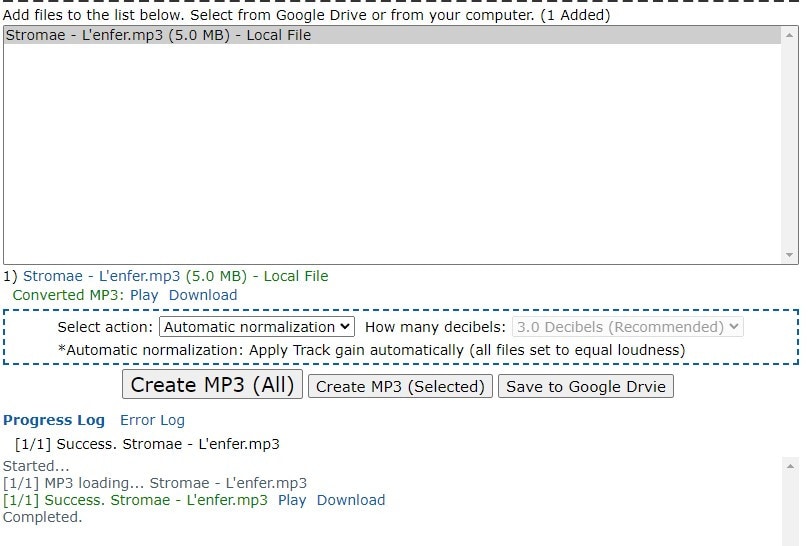
Sodaphonic
Sodaphonic also lets you edit your audio files online. With the help of this editor, you can cut, copy, and paste sound segments of an audio. It offers you: normalizing audio, using audio effects, time-stretching, reversing audio, fade-in and fade-out – those tools are really helpful.
Sodaphonic is pretty interesting as the first thing that meets the eye is that it lets you not only pick or drop an audio file there, but record something new, too!
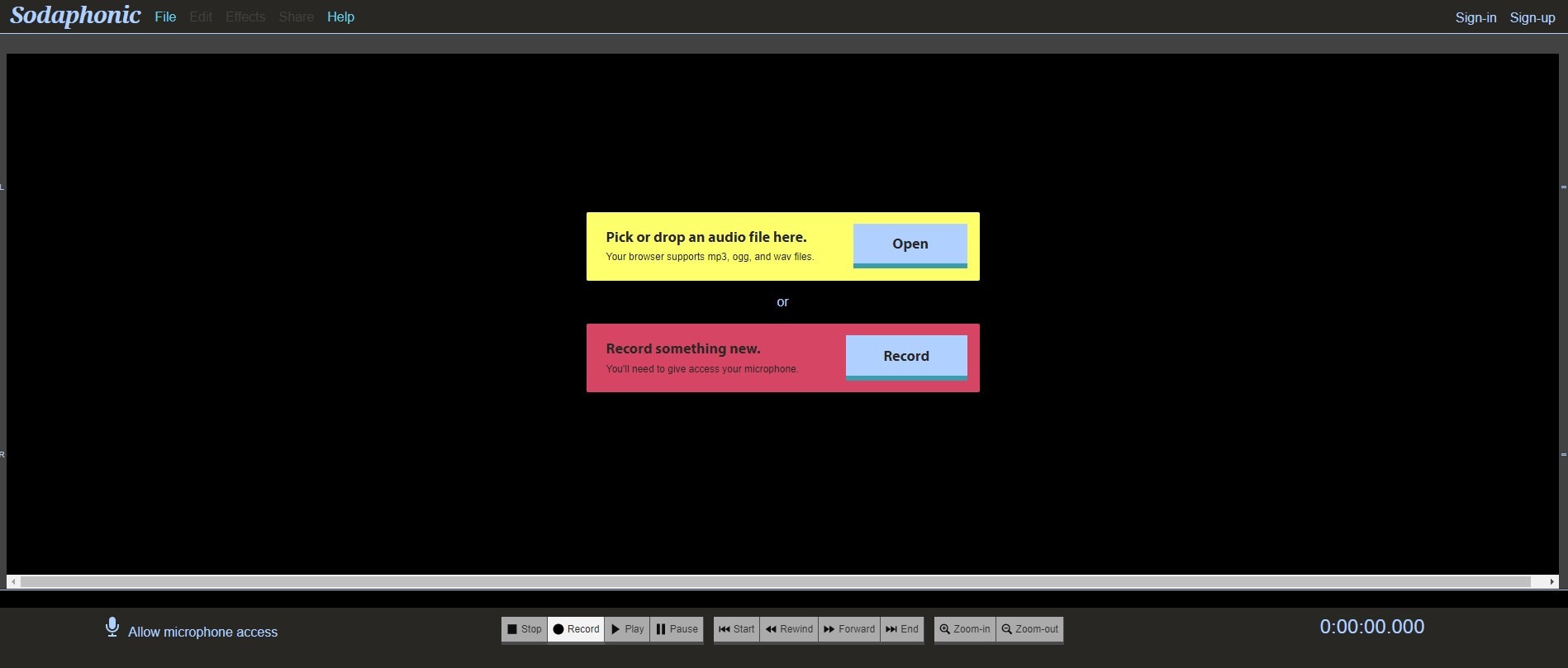
Any option you choose, then when proceeding into the editor, you will see your file waveform there. In order to normalize the audio, on the top left, find Edit, put a cursor on it, and you will see the menu appear. Find Normalize and click on it.
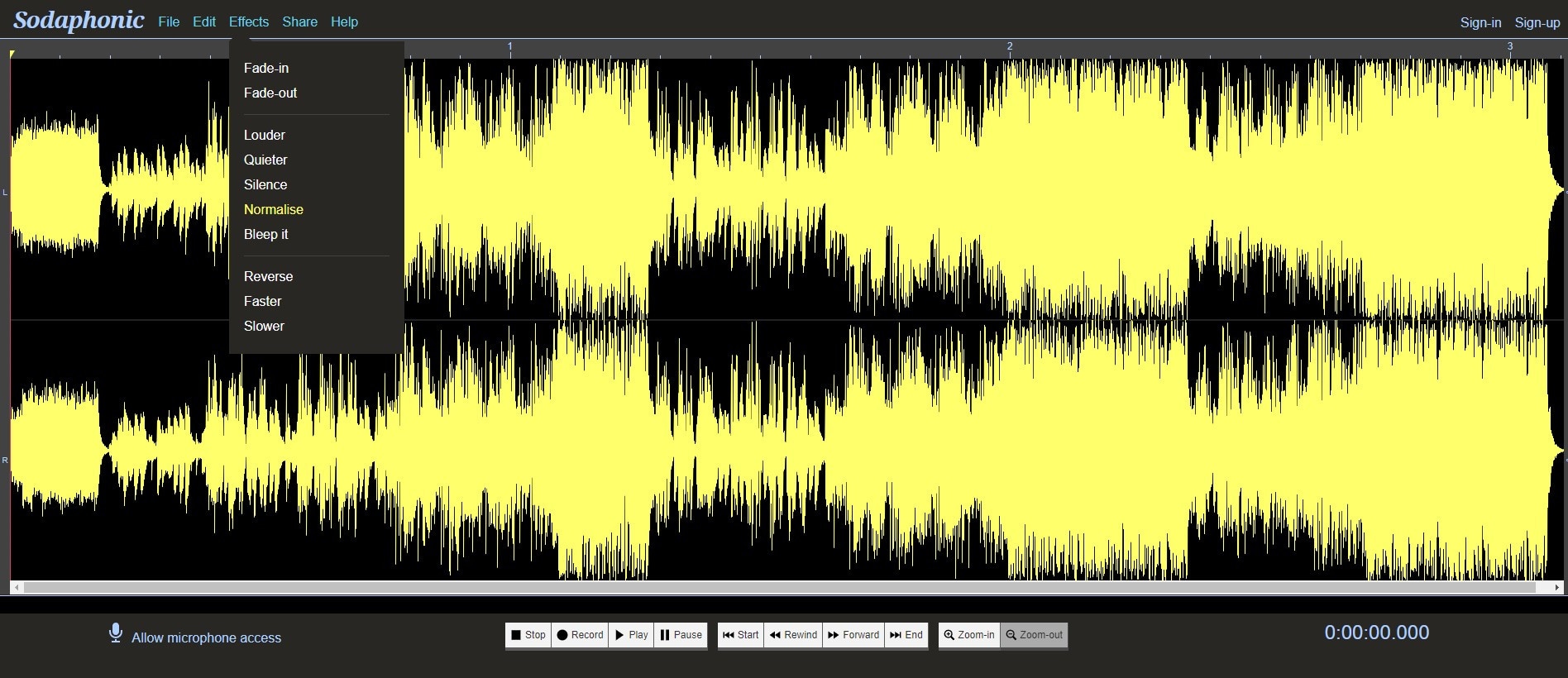
A little window will appear, where you need to fill in how many decibels should be set as the max peak.
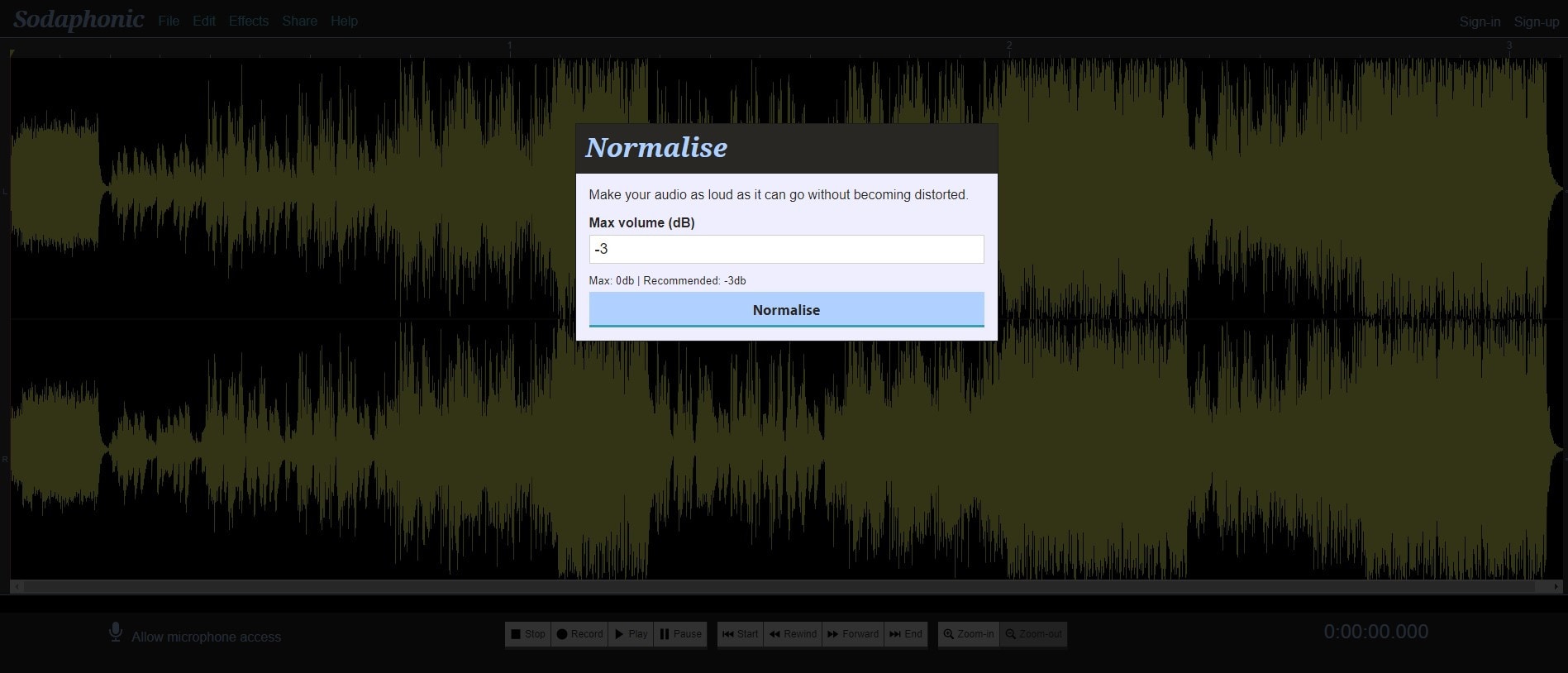
Once you do this and click on Normalize, your file will now be affected, and you can also compare the waveform – it is now a little different, isn’t it?
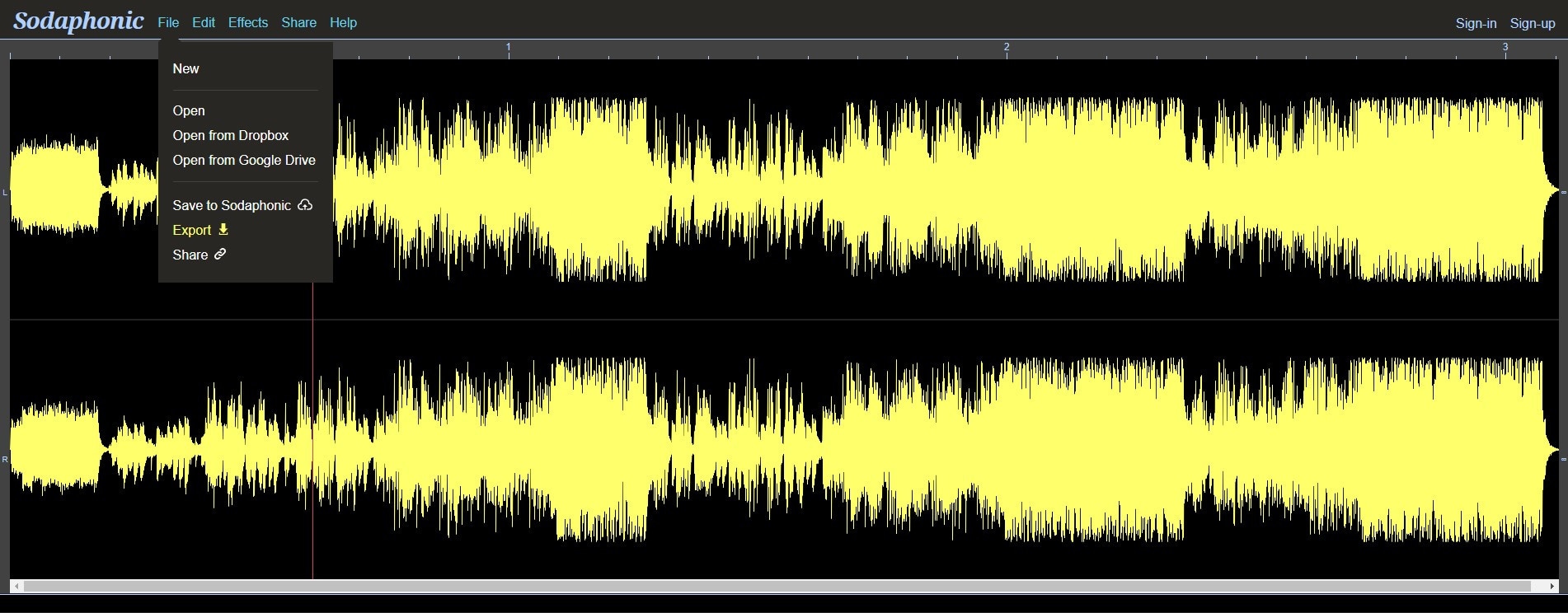
So, when you are happy with the result, just go to File, and Choose Export.
Audio Mass
The Audio Mass editor will help you edit audio and waveforms over the web. There, you can load any audio format your browser supports, and apply many different audio effects (fading in, cutting, trimming…)
So, Audio Mass lets you: normalize audio, analyze frequency, signal distortion and peaking, trim, past, cut audio segments, reversing and inverting audio, convert to MP3, change of volume levels, fade in and fade out, audio compressor, adding reverb, delay, distortion.
When you go to the web-site , you can choose your desired file right away and the site will open it in a waveform. Now, the Normalize option is in the Effects (in the menu on the top). Click on it.

The window opened will show the option to Normalize Left and Right Equally, and it also doesn’t give you decibels – instead, you can choose the percentage on how you would like it to be normalized.
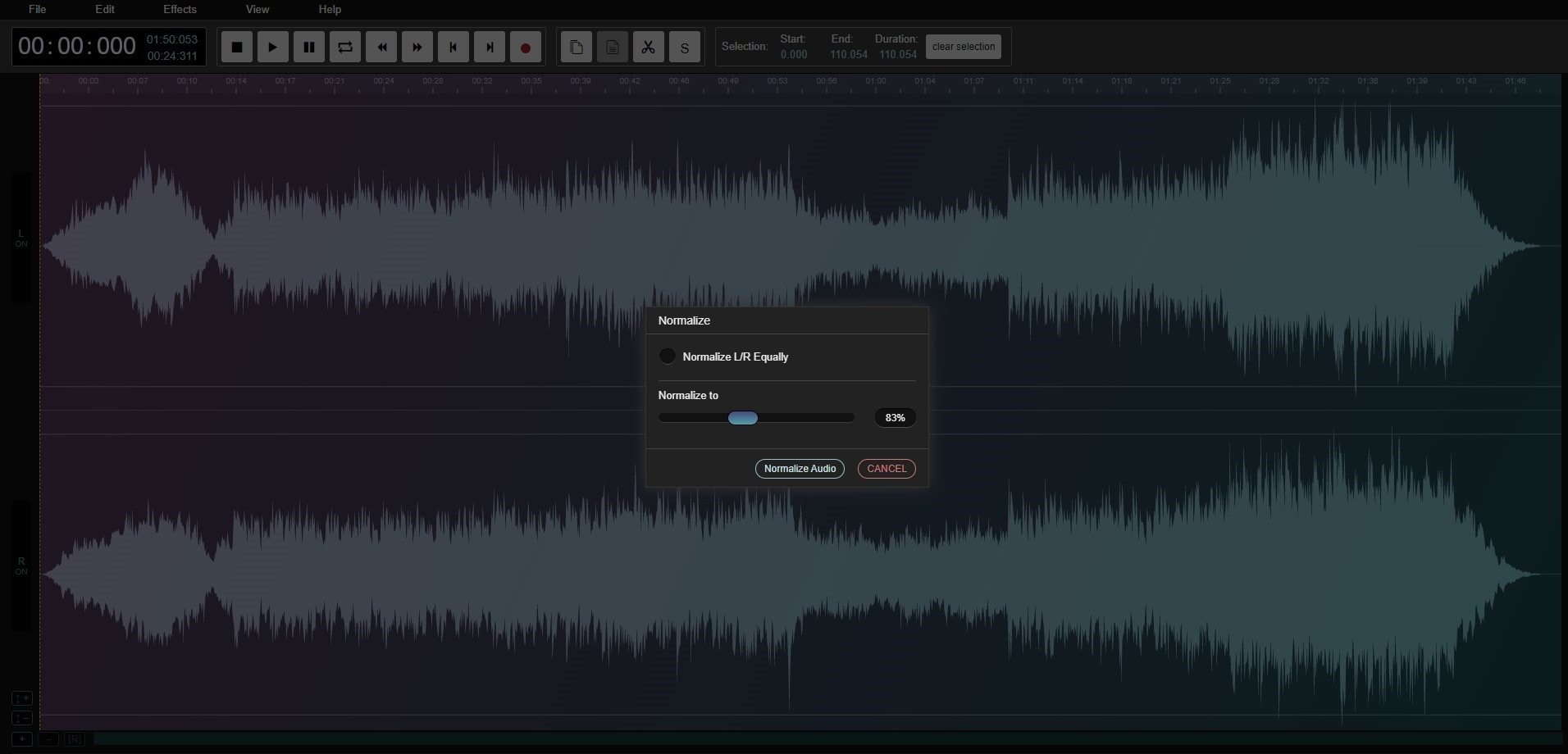
Then, surely, click on the Normalize Audio button and enjoy the result – the waveform itself will show you how different the file becomes…
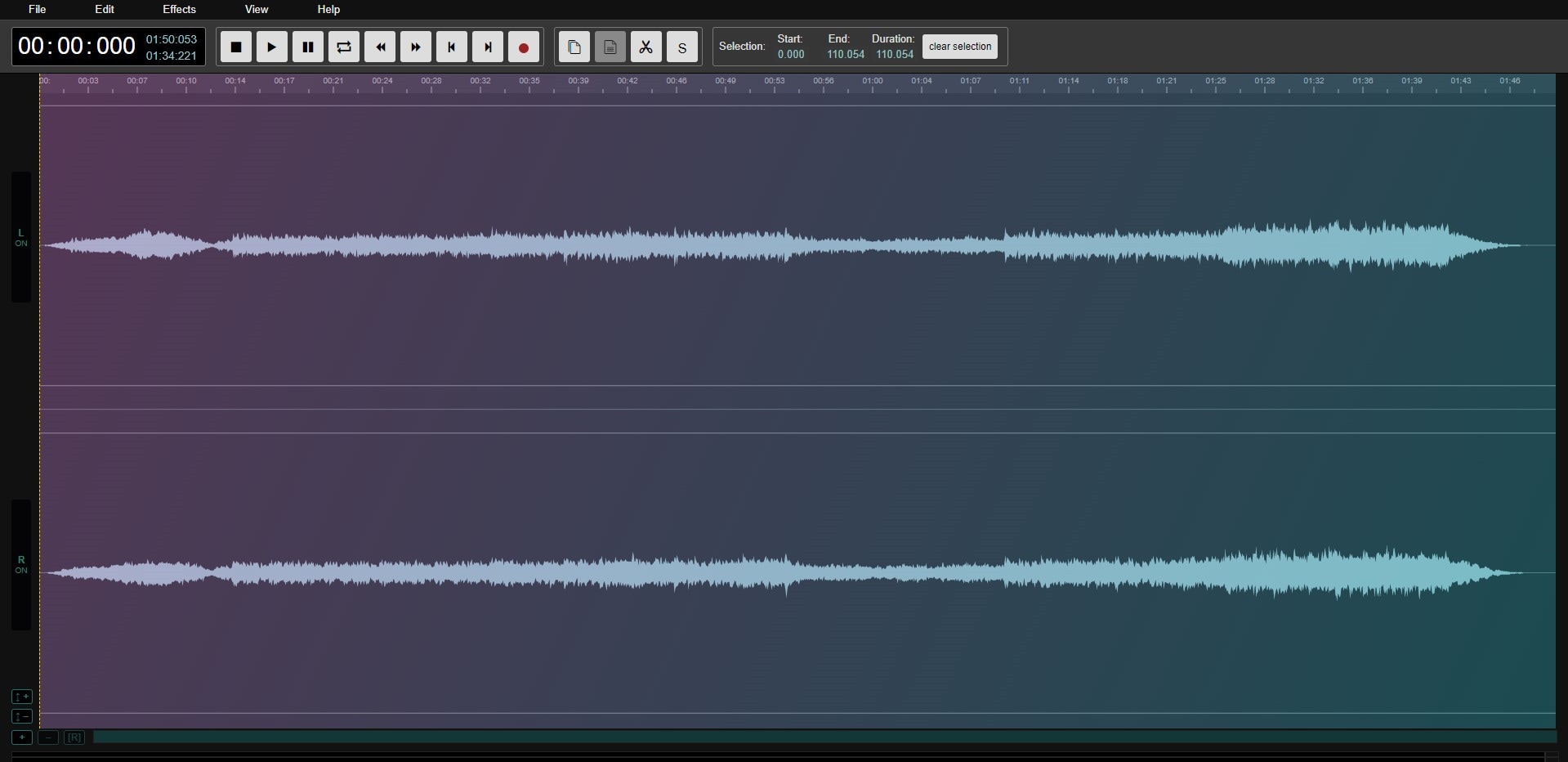
Audio online convert
This is the tool mostly to be used to convert to different audio formats. In the process if converting audio, you will be able to normalize audio too, as well as change bitrate, sample rate, audio channels, and more.
Go to Audio Online Convert . Of course, click on Choose File and find the track you want to normalize.
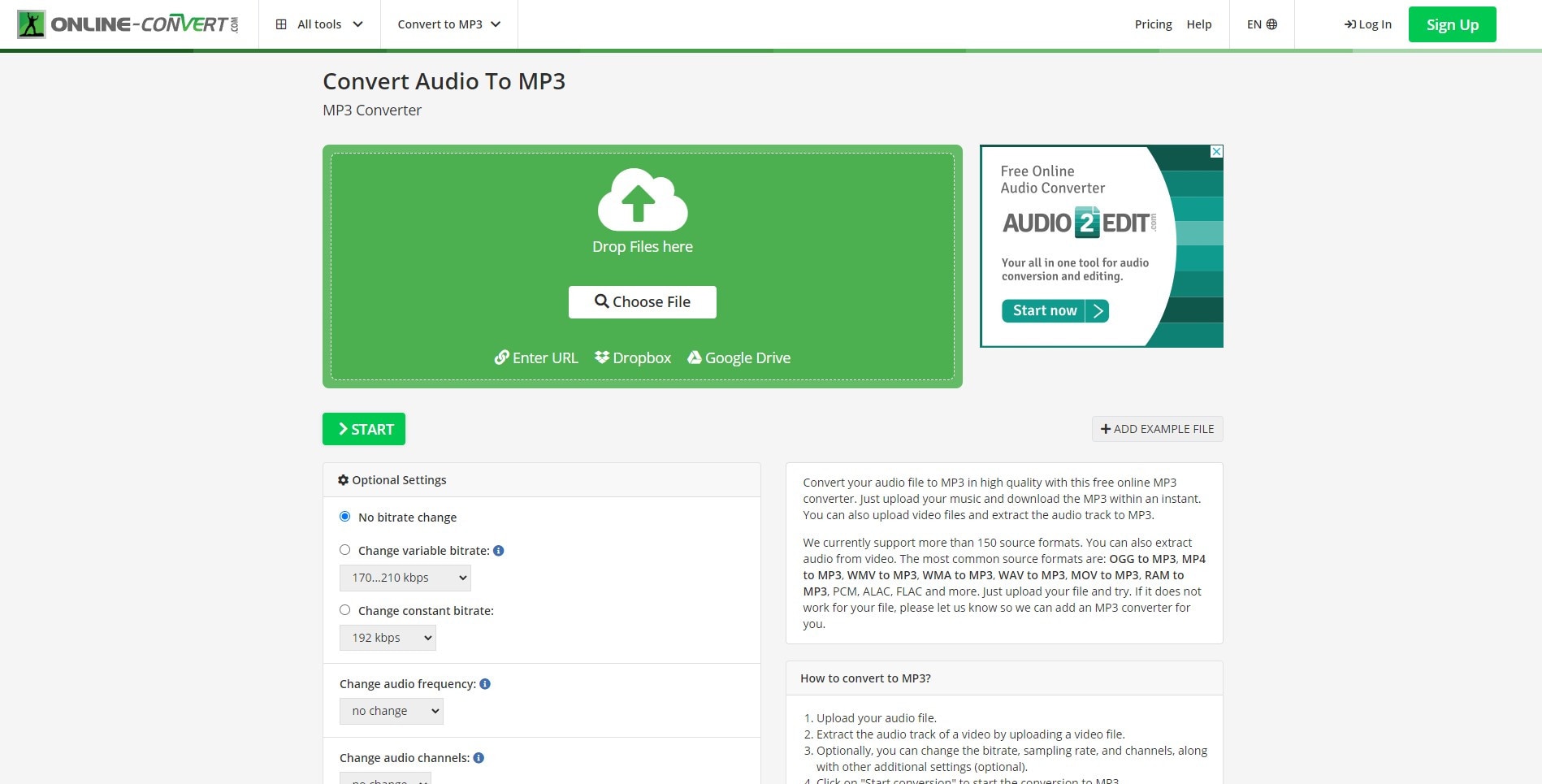
Below, you have some settings you can work on, which we have already mentioned. So, if we focus on our article’s topic, you need to find the option Normalize audio, and check the box there. Then, click to Start and the web-site will work on the track according to what you decided to change there. You will have a little while your file is being processed.

So, when it is completed and your file is ready, just click on Download and you are ready to use it as you like.
Audio editor
The DikTorov Audio Editor is an online app to edit audio, normalize audio, or fade in / out audio. It offers: real-time editing and playback of audio files, supports all popular audio formats, and exports as WAV.
Go to the web-site , choose your file and drag it in the blue space in the center.
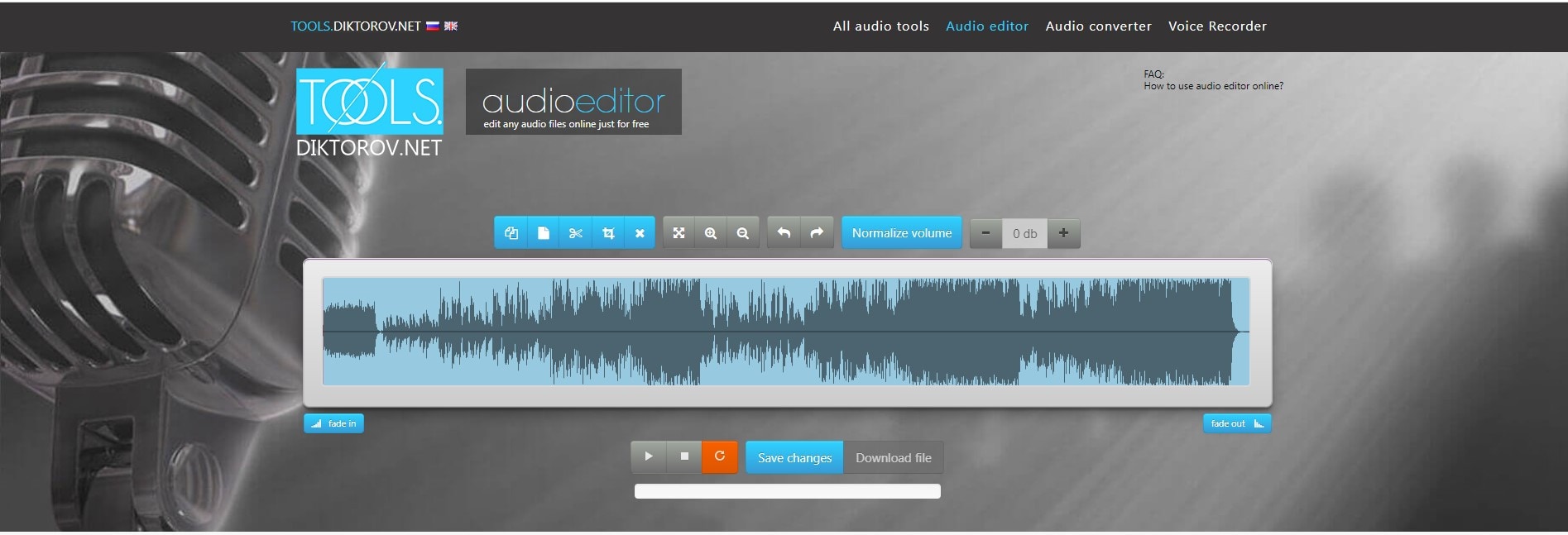
Now, find the blue Normalize Volume button on the top form the audio waveform, notice that on the right of it, you can change the dBs, and fill in your desired max peak decibel. Then, click on the button Normalize Volume, and the setting will be applied onto your track.

fConvert Online Converter
fConvert is an audio converter service that converts any audio file to any format. There, you can: normalize audio, change sample rate, change file format.
Go to the fConvert , Choose File from your computer, do the settings, and don’t forget to check in the box next to Normalize at the end of the settings.

For the conversion process to start, click on fConvert. Then, scroll down a little, and you’ll find that there is a Result you can already download!
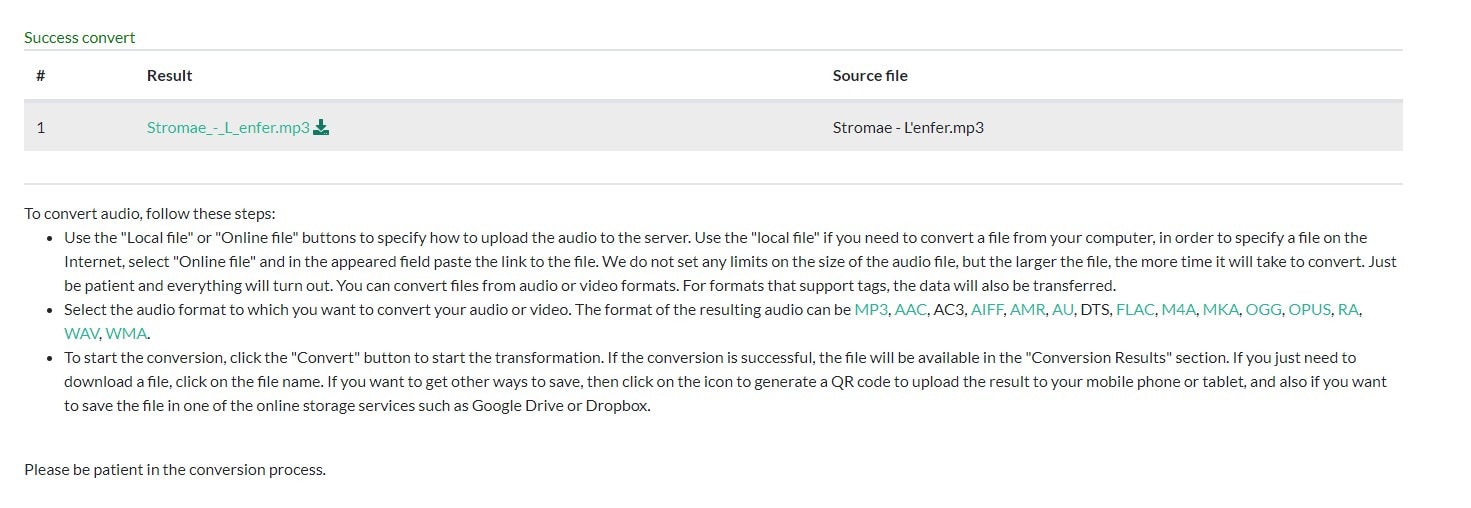
Boost MP3 Volume
The MP3 Volume tool can increase or decrease the volume of any MP3 file online, change file from 1 to 25 decibels, and adjust one or both audio channels.
Open the web-site in your browser, select MP3 file, which should be no more than 150 MB, and take care of the settings.
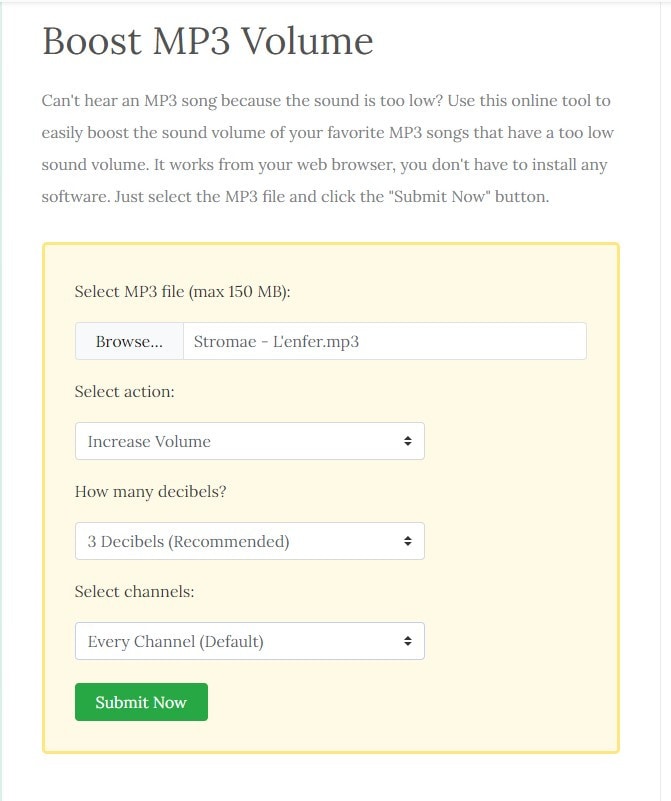
So, as we mentioned, here you can increase or decrease the volume, and choose your desired max peak (3 decibels recommended everywhere!), and select channels – both or only right or left.
Then, click on Submit Now, wait a little while your file is being uploaded, and once it is finished, you will see the download link on the top of the settings box.
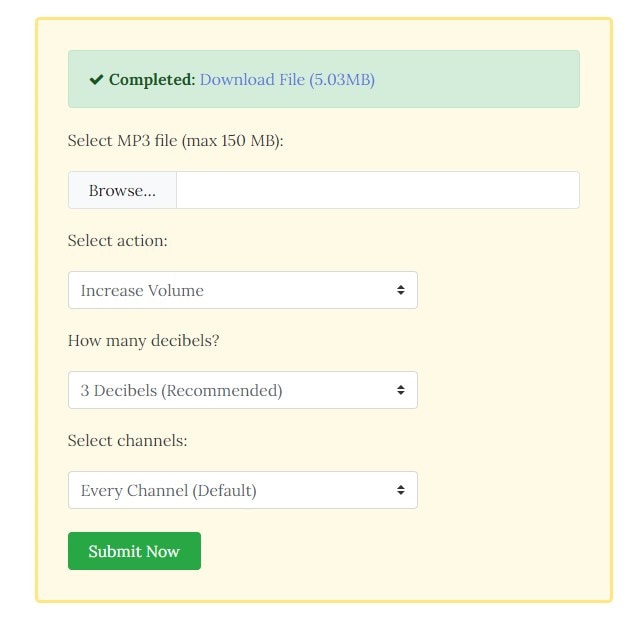
MP3Cut Change Volume
The volume changer app lets you increase audio volume while maintaining the original audio quality. It supports all audio file formats including MP3, M4A, WAV, M4R, FLAC… as an audio converter, it lets you save files in any desired format. Of course, it doesn’t require that you have any technical skills, just move the slider to adjust the volume. It’s very easy to use and offers unlimited file size.
Open MP3Cut , and click on Open file.

Now, instead of Normalize, in this case, you will have to look for the word Equalizer, which you can find in Audio Tools on the top menu. Click on it, wait, and you will see the sliders appear below the waveform of the track.
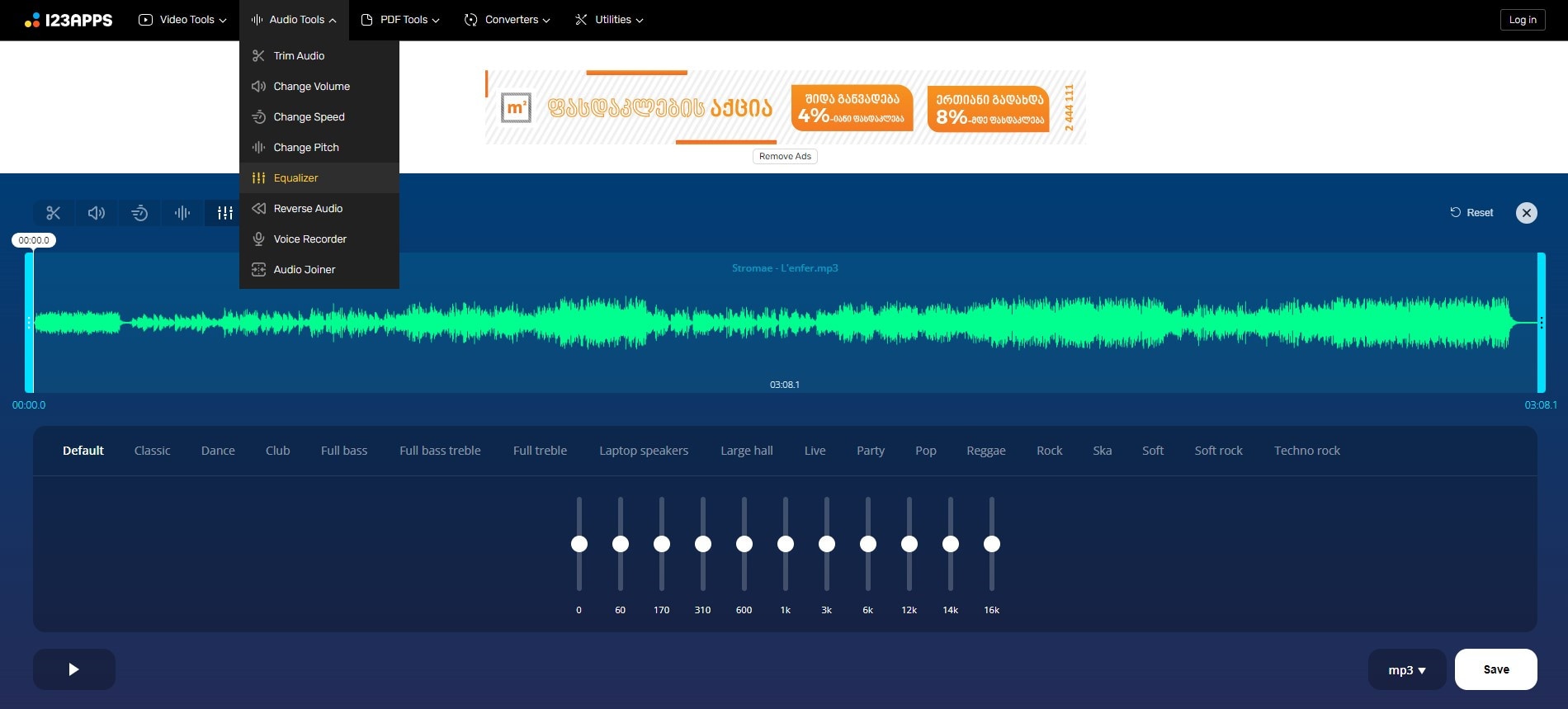
The sophisticated app also lets you choose the options to select the one most compatible with your audio track, such as: Default (it can be anything, surely), Classic, Dance, Laptop speakers, Live, Party, etc…
You can equalize your track by playing around with the sliders, and then save the result when you are satisfied with the result.

Audio Alter Volume Changer
You can raise or lower the volume of any audio file using this free online tool. Its main advantages are that it’s fast and easy to use, and supports MP4, WAV, FLAC, OGG.
After opening the web-site , now click on Browse computer button to select your file. It will prepare your file and as in most cases, the waveform will appear.
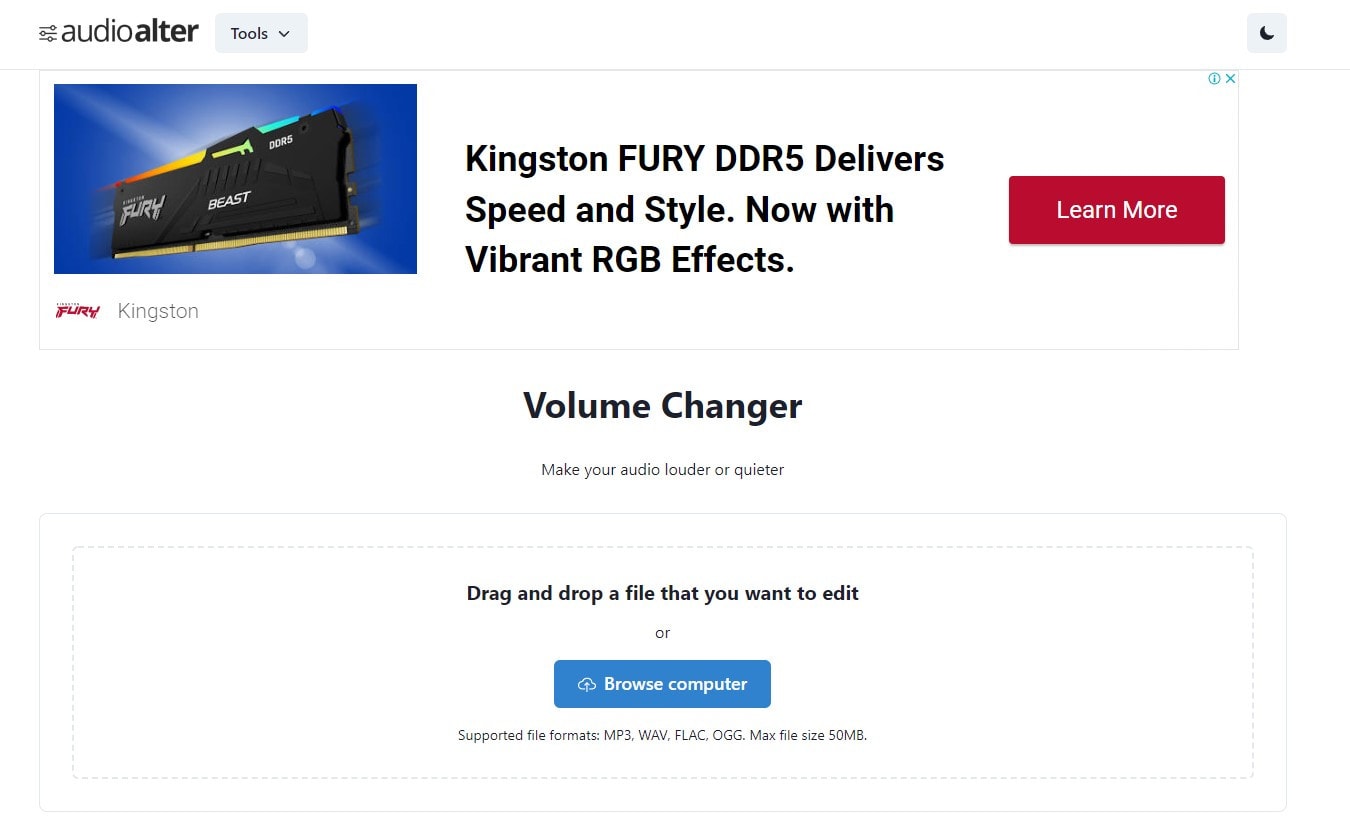
Below, there is a decibels line, where you can once again select your desired max peak dB.
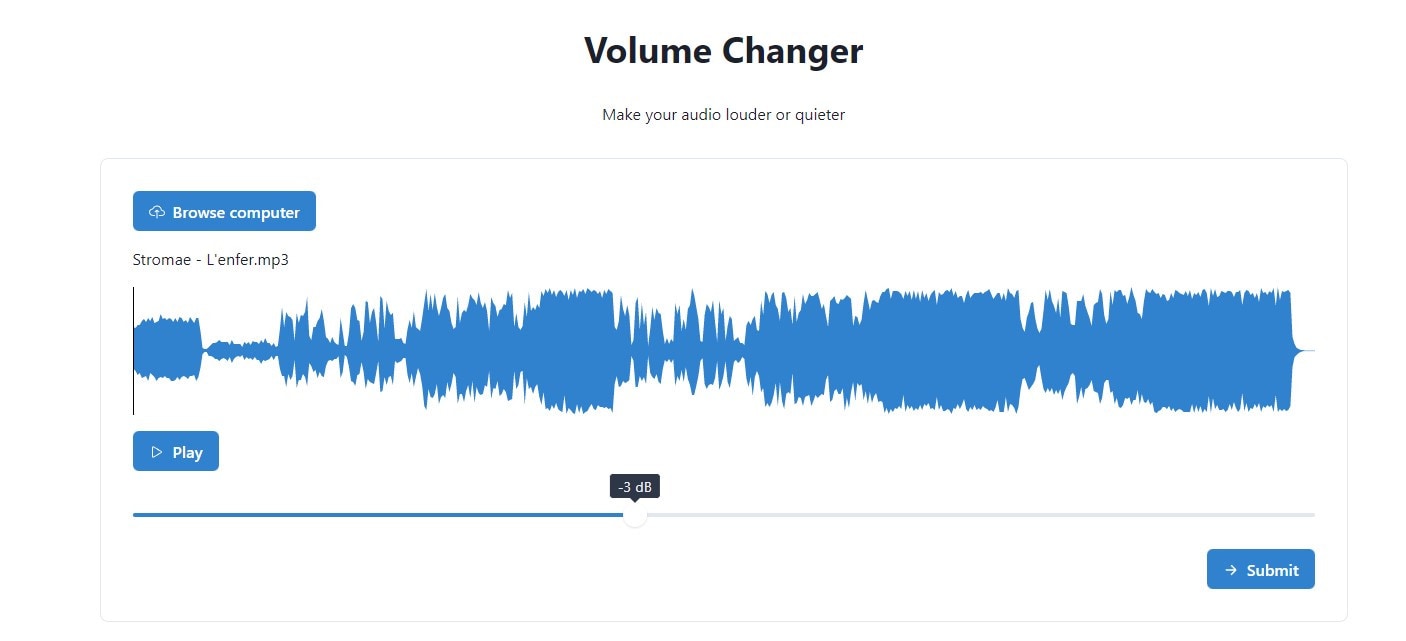
After you have set your dB to the desired amount, click on Submit and wait while your file is being processed. After that, when the audio is converted, you can download it, and also, go back to the main page and edit another file.

Audio Trimmer Volume Booster
This is a free online audio file volume booster. With it, you can very easily increase the volume of songs and make your MP3s louder. Supported formats are: MP3, WAV, WMA, OGG, M4R, M4A, FLAC, AIFF.
Open the site , and find a black line where you will see the option to upload your track. Click on Choose File and select your desired track from your computer.

Now, on the right side under the black line where we uploaded our file, you can see the Loudness options. Click on it and choose from the following: Mild, Moderate, High, and Extreme. Once you have chosen, click on Boost Volume. It will process and in a few seconds, you will have your file ready for download!

Normalize audio in Wondershare Filmora X
Now, even though we already know 10 (which is a lot!) free online normalizers, and we really hope you will be able to choose among them and reach your goal in an easy way, it might be even better if we know some more about normalizing audios using a software.
It is almost as easy to use, but what if you need some more editing opportunities, and with a simple interface? – in this case, worth discussing is a software called Wondershare Filmora X , which helps us have a wonderful, and share-able results. (as the name itself suggests!) It is an actual video editor, and many people all around the world enjoy its presence, especially the ones who don’t want to use a program so sophisticated and complicated for them to require learning for months, but try to have some main editing tools at hand. Filmora operates on Mac and Windows, its interface is very easily understandable for beginners right away. It’s worth noting that not a long ago, Wondershare Filmora X introduced the feature to normalize the audio for the first time. So, go on, download the latest version of Filmora X, and follow along the detailed step by step guideline to normalize audio there!
Free Download For Win 7 or later(64-bit)
Free Download For macOS 10.14 or later
When it is done installing, open the software. Click and drag the video of which the audio you want to normalize. Select the clip you have chosen – if there are multiple, select all of them, then right-click and choose Detach Audio.

You will see that there is a kind of graphic before your eyes, and if you can see that the waveform is not so equal, you can be pretty sure without even listening, that the noises are so much different from each other, which makes us understand once more, how useful and sometimes, even necessary, audio normalization can be:

Select the files you want to balance, right-click and click on Adjust Audio. New panel will be opened on left top and there, you will see Auto Normalization appear – check the box next to it.
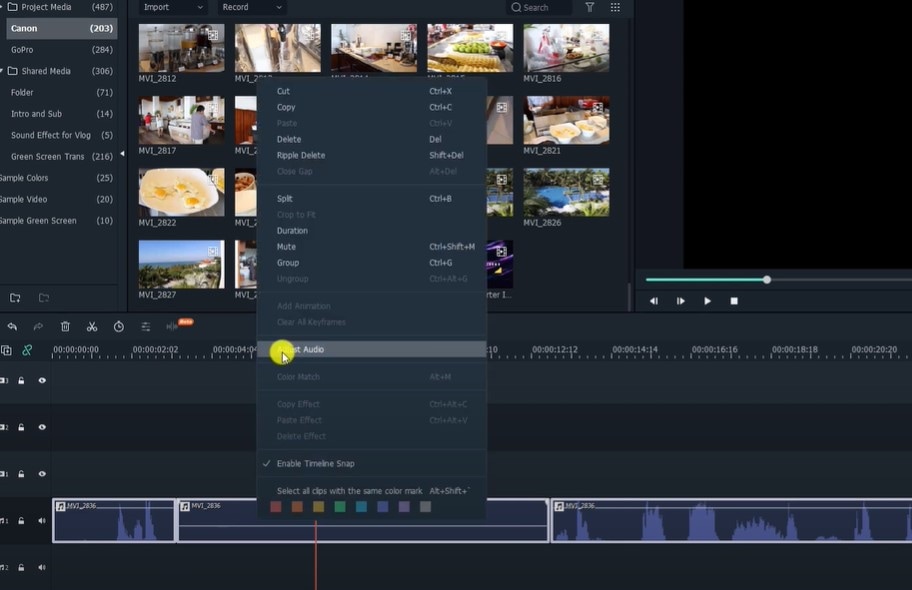
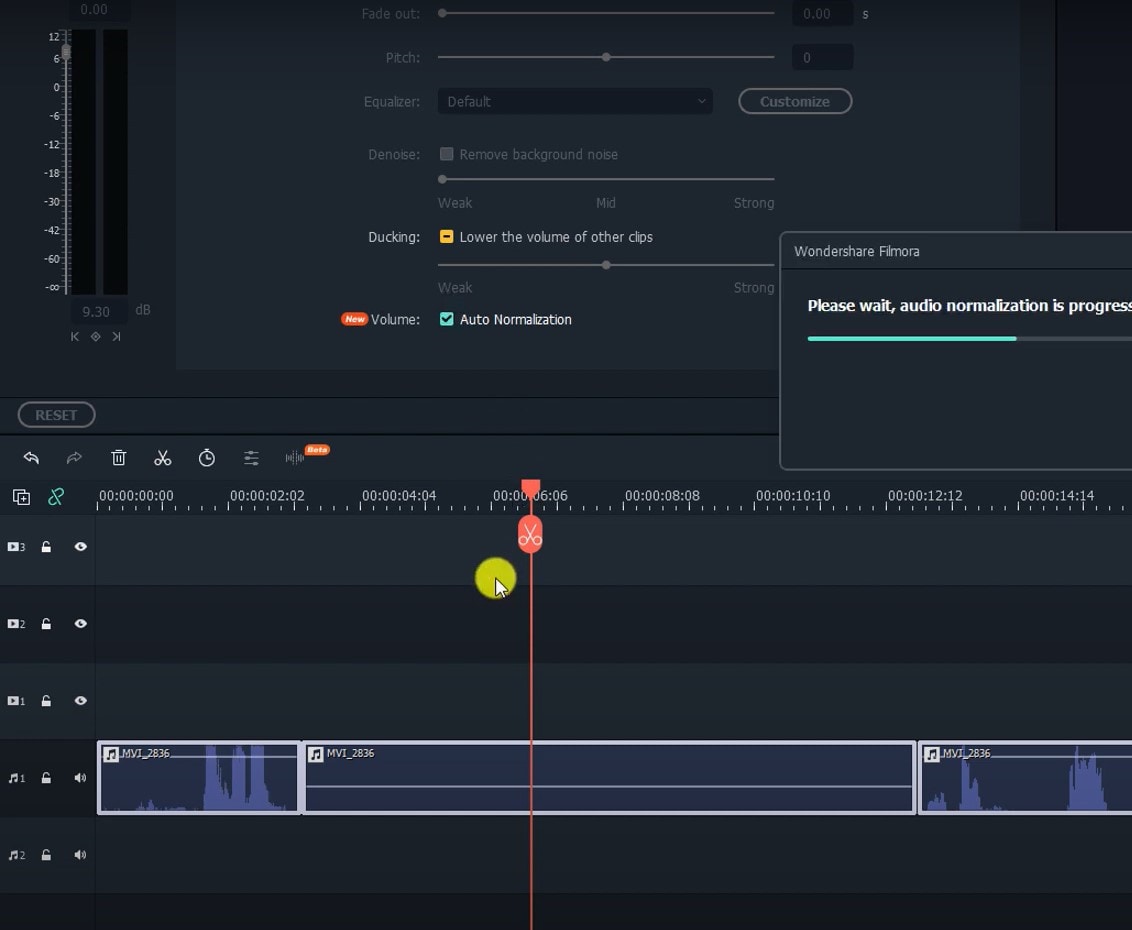
After you have clicked on it, wait until the normalization completes.

With it being done, all your audio clips will be normalized, you will now be able to see on the graphics that the volumes are almost on the same level and when you listen to it, you will make sure that there is not a noticeable difference between how they really sound. So, now you can just go and save the file you have just normalized!
So, in this article, we have learned about audio normalization, we have answered some questions about what it is, why and when do we need it, which are the 10 best online editors that will help us normalize our audio tracks without really wasting a lot of time and installing a software, but we also touched upon one software Wondershare Filmora X which can help us carry out the same task in no time. The best thing we can learn from this article is that there are just countless ways of doing one thing, and in today’s world, we are full of resources to reach our targets and aims. So, we hope this article helped you choose your favorite tool, and facilitate working on the audios for you – until next time!
Free Download For macOS 10.14 or later
When it is done installing, open the software. Click and drag the video of which the audio you want to normalize. Select the clip you have chosen – if there are multiple, select all of them, then right-click and choose Detach Audio.

You will see that there is a kind of graphic before your eyes, and if you can see that the waveform is not so equal, you can be pretty sure without even listening, that the noises are so much different from each other, which makes us understand once more, how useful and sometimes, even necessary, audio normalization can be:

Select the files you want to balance, right-click and click on Adjust Audio. New panel will be opened on left top and there, you will see Auto Normalization appear – check the box next to it.


After you have clicked on it, wait until the normalization completes.

With it being done, all your audio clips will be normalized, you will now be able to see on the graphics that the volumes are almost on the same level and when you listen to it, you will make sure that there is not a noticeable difference between how they really sound. So, now you can just go and save the file you have just normalized!
So, in this article, we have learned about audio normalization, we have answered some questions about what it is, why and when do we need it, which are the 10 best online editors that will help us normalize our audio tracks without really wasting a lot of time and installing a software, but we also touched upon one software Wondershare Filmora X which can help us carry out the same task in no time. The best thing we can learn from this article is that there are just countless ways of doing one thing, and in today’s world, we are full of resources to reach our targets and aims. So, we hope this article helped you choose your favorite tool, and facilitate working on the audios for you – until next time!
Also read:
- [New] In 2024, How Often Should You Upload YouTube Videos to Get More Views
- [New] In 2024, Visual Unity AI-Driven InstaVideo Compilation
- 2024 Approved Enhance Your Viewing Pleasure with Top Windows Vids
- 2024 Approved HDMI 2.1 Master List In-Depth Screen Comparisons
- Boosting Collaboration Mastery of Zoom Capabilities in Win10
- Cutting Edge Computing Select the Optimal Device for Video Editing for 2024
- Embrace the Future of TV Engage with FB Live via Roku for 2024
- In 2024, Why Your WhatsApp Location is Not Updating and How to Fix On Oppo A38 | Dr.fone
- New 10 Best Podcasting Audio to Text Transcription Software FREE&PAID
- New 2024 Approved AIFF to MP3 An Experts Methodology for Audio Conversion
- New 2024 Approved Cybercast Seminar Key Concepts and Deeper Understanding
- New 2024 Approved Silence in Streaming Advanced Tips for Reducing Online Background Noise
- New Add & Edit Background Music to Video with Filmora for 2024
- New High-Quality VOIP Games Chat Tools to Elevate Your Experience - 2023 Update
- New In 2024, From Raw Audio to Polished Masterpiece Editing with Avidemux - 2023 Edition
- New In 2024, The Ultimate Guide to Silencing Sounds Cutting Audio From iPhones/Mac Videos
- What To Expect When Ordering Early: A Guide for the Anticipated Apple Vision Pro Release
- Title: The Essential Guide to Equalizing Audio Volumes in VLC Media Player for 2024
- Author: Kate
- Created at : 2024-10-13 16:27:48
- Updated at : 2024-10-17 16:15:19
- Link: https://audio-editing.techidaily.com/the-essential-guide-to-equalizing-audio-volumes-in-vlc-media-player-for-2024/
- License: This work is licensed under CC BY-NC-SA 4.0.

